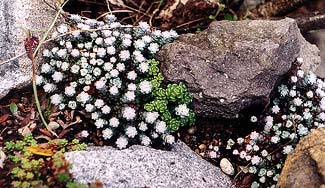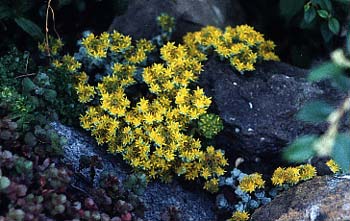
Cape Blanco Stonecrop
"The faintness of the stars, the freshness of the morning,
The dewdrop on the flower, speaks to me."
-Chief Dan George
(1899-1981)
(1899-1981)
Sedum spathulifolium ssp. pruinosum 'Cape Blanco' is a lovely little sedum with grey-white succulent rosettes. The thick leaves are actually green but with a powdery coating that makes them appear white. Also showing in the first photo is a bit of a plain green Oregon Stonecrop (S. oreganum) which has begun to invade the white one's space. I should probably remove that, as Oregon Stonecrop can get pretty aggressive if permitted to wander far from its intended confines.
I obtained the Cape Blanco Stonecrop when it was a three inch square. One year later it had spread so much, forming a mat only two or three inches tall. As early as May & throughout summer it has branching clusters of star-shaped yellow flowers, shown in the second photo taken at dusk one day in June.
 Cape Blanco is a cultivar of a species native to the Pacific Northwest, a wildflower of Oregon & northern California. The species sedum is known as Pacific Broadleaf Stonecrop, itself having several commonly gardened varieties.
Cape Blanco is a cultivar of a species native to the Pacific Northwest, a wildflower of Oregon & northern California. The species sedum is known as Pacific Broadleaf Stonecrop, itself having several commonly gardened varieties.The wild form grows on rocky outcroppings & along trails, often where it is partly shaded by Douglas fir or yellow pine.
'Blanco' means "white" alluding to the color of the fleshy leaves, but 'Cape Blanco' is named for a cape near Port Orford, Oregon, on which stands a lighthouse furthest south of any in the state, & which is today part of a state park. The lighthouse was built in 1870. In 1903 it became the first Oregon lighthouse operated by a woman, Mable E. Bretherton.
In a rockery garden this plant prefers considerable sunlight but unlike most sedums, it doesn't mind a bit of shade. It is important that the soil drains extremely well, or it can rot from having its roots too long in water, being truly adapted to spreading itself over dry rocks. So long as it is not too wet, it is one of the hardiest plants imaginable, & easy to start just from breaking a hunk off & transplanting that.
The flat, fat, succulent leaves are edible & have been used raw as a vegetable garnish, or can be fried with other vegetables, or added to soups. If you're lost & frightened in the dry hills of southern Oregon & it looks like you've just about had it from starvation & are being stalked by a catamount, go ahead & gobble down some sedums, you'll get some moisture from them too. Then you'll be sturdied up for hand-to-hand combat with the cougar.